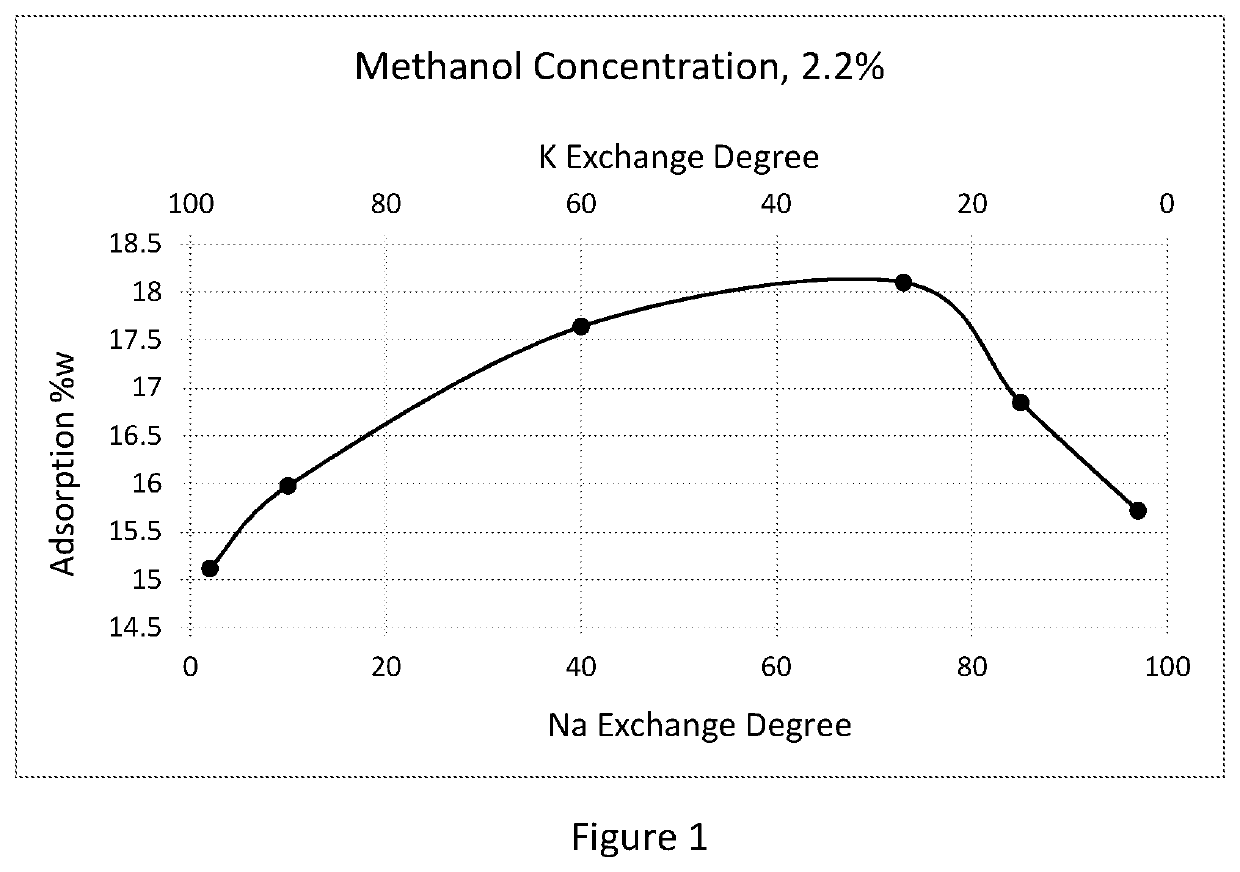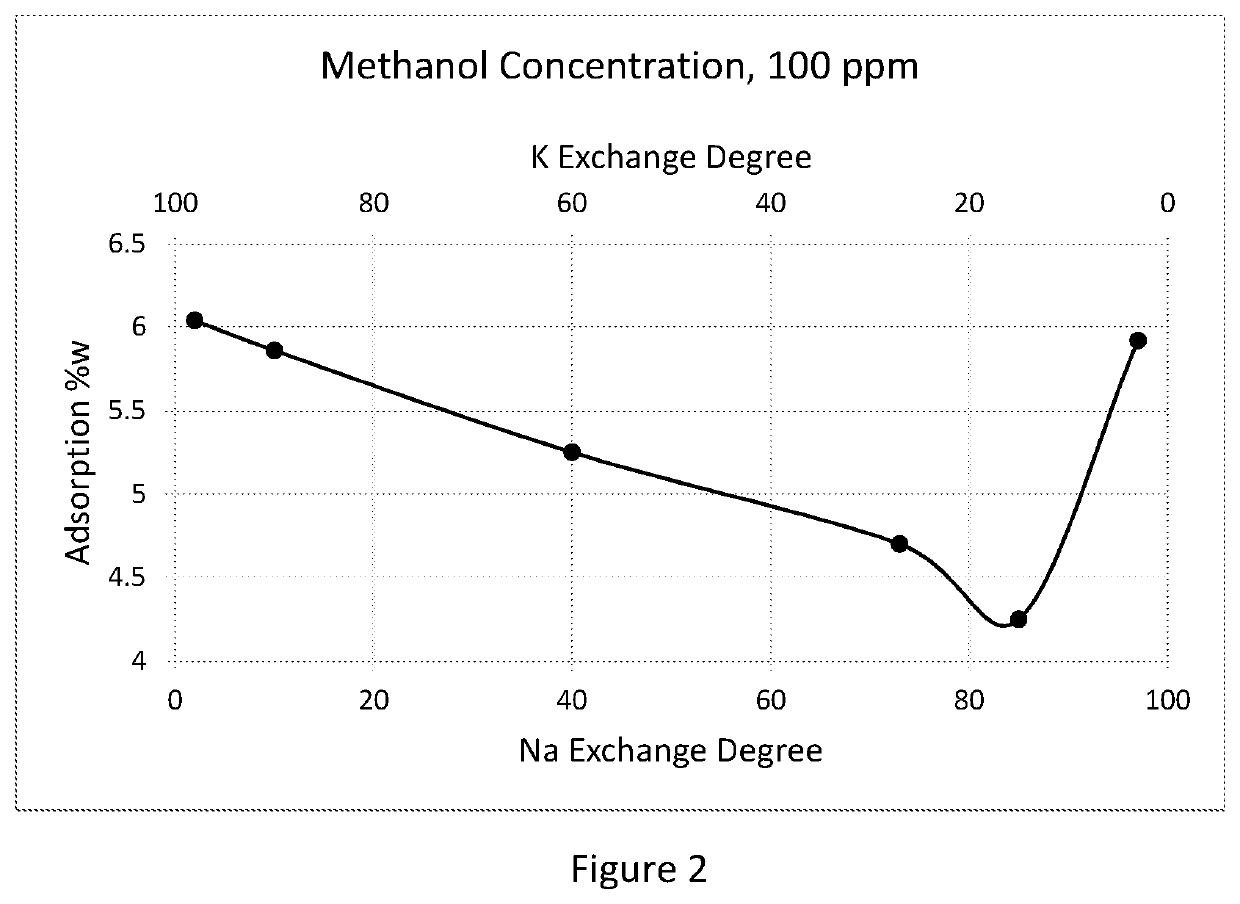Adsorbent and process for methanol and oxygenates separation
a technology of methanol and oxygenates, applied in separation processes, gaseous fuels, other chemical processes, etc., can solve the problems of reducing the economic viability of methyl-carboxylic acid esters, and preventing the economical reclaiming of regeneration liquid, etc., to achieve high selectivity for alcohol adsorption, increase the methanol capacity of adsorbent beds, and high efficiency
- Summary
- Abstract
- Description
- Claims
- Application Information
AI Technical Summary
Benefits of technology
Problems solved by technology
Method used
Image
Examples
examples 1 to 4
Sample Preparation According to the Invention
[0046]Beaded sodium- potassium LSX molecular sieve having Si / AI ratio of 1, a Na+ion exchange degree of 76% and a K+ion exchange degree of 23% equiv. was used as an Example 1 sample and as an initial material for additional sample preparation.
[0047]To increase Na content up to 85% equiv., in Example 2, 300 g of the initial material was treated at ambient temperature by contacting the material with 3 liters of 1.5 N solution of sodium chloride over 4 hours. The material was washed with deionized water (DIW) to remove excess of chloride ions, dried at 110° and calcined at 250° C.
[0048]In Example 3, 200g of the NaKLSX adsorbent of the sample of Example 2 received treatment with 1L of 2.5 N NaCl solution to raise its ion exchange degree to 97%.
[0049]In Example 4, 100 g of the material of Example 3 was treated at 80° C. with 1 L of 3.5 N solution of sodium chloride and then dried and calcined to obtain a mono-cation NaLSX sample.
[0050]Followin...
examples 5 to 8
Preparation of Samples According to the Invention
[0055]In Example 5 a sample with increased K+ cation content was prepared from the Sample of Example 1 by its treatment with a 1 N solution of KCl at ambient temperature followed by repetition of the sample washing, drying and calcining procedures of Example 2.
[0056]Examples 6 to 8 produced samples having an elevated potassium cation content obtained by treatment of the sample of Example 5 with a 2N KCl solution at 70° C. (Example 6), a 3N KCl solution at 85° C. (Example 7) and a 4.5 N KCl solution at 90° C. (Example 8).
[0057]AAS analysis of the samples showed the following cation presence in the adsorbent compositions:
[0058]Example 5: K+—60.5%, Na+—39.0%, Ca2+—0.5% (equiv.);
[0059]Example 6: K+—90.8%, Na+9.0%, Ca2+—0.2% (equiv.);
[0060]Example 7: K+—98.2%, Na+—1.8%, Ca2+—0% (equiv.); and,
[0061]Example 8: K+—99.2%, Na+—0.8%.
examples 9 to 13
Samples Preparation According to the Invention
[0062]A tri-cation CaNaKLSX sample was obtained for Example 9 by ion exchanging the original NaKLSX adsorbent of Example 1 with 1N solution of calcium chloride.
[0063]In Examples 10 and 11 bi-cation CaNaLSX samples were prepared by treatment of NaKLSX adsorbent of Example 3 with 1 and 2.2 N solutions of CaCl2 respectively.
[0064]The bi-cation CaKLSX sample of Example 12 was prepared by ion exchange of the KLSX adsorbent of Example 7 with a 1N solution of calcium chloride.
[0065]The mono-cation CaLSF sample of Example 13 was obtained by consecutive treatments of the adsorbent of Example 3 with four treatments. The first three treatments were with 1.0, 2.2, 3.0 N solutions of CaCl2 at ambient temperature followed by treatment with a 5.6 N solution at 90° C.
[0066]According to the analysis, the samples have the following cation composition:
[0067]Example 9: Ca2+—63.4%, Na+24.9%, K+—11.7% (equiv.);
[0068]Example 10: Ca2+—32.6%, Na+—67.2%, K+—0.2% ...
PUM
| Property | Measurement | Unit |
|---|---|---|
| pressure | aaaaa | aaaaa |
| temperature | aaaaa | aaaaa |
| pressure | aaaaa | aaaaa |
Abstract
Description
Claims
Application Information
 Login to View More
Login to View More - R&D
- Intellectual Property
- Life Sciences
- Materials
- Tech Scout
- Unparalleled Data Quality
- Higher Quality Content
- 60% Fewer Hallucinations
Browse by: Latest US Patents, China's latest patents, Technical Efficacy Thesaurus, Application Domain, Technology Topic, Popular Technical Reports.
© 2025 PatSnap. All rights reserved.Legal|Privacy policy|Modern Slavery Act Transparency Statement|Sitemap|About US| Contact US: help@patsnap.com


